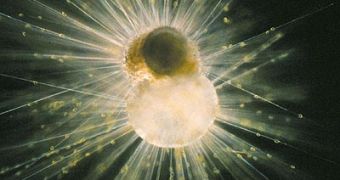These are more than simple Amoebas: the single-celled animals called Foraminifera, floating in the plankton, are amongst the most abundant organisms in the ocean's organic mass. Many produce bioluminescence seen in the ocean during the night and the largest species, even if they do not oversize a fingernail (which is already extraordinary, as there is just one cell), can catch and ingest creatures many times bigger than their own mass.
Foraminifera are essential in recycling elements in the oceans: they build carbonate shells and due to their sheer numbers, they work like a "carbon sink", absorbing carbon and calcium from the water. Their beautifully colored shell even forms pink beaches in the Bahamas!
Sam Bowser, for the New York State Department of Health's Wadsworth Center, has been studying Antarctica's Foraminifera for 20 years, having dived many times in the frigid, yet biologically rich, waters of McMurdo Sound.
Bowser's main goal is to understand as much as possible from the Foraminifera's biology: habitat, life cycle, reproductive patterns, eating habits, evolution, but he's particularly interested in how they build minute, yet sophisticated coverings out of grains of sand employing an extremely effective underwater adhesive.
His efforts in decoding the chemistry of the naturally produced glue could lead to the synthesis of stronger biological adhesives, extremely necessary in fields like dentistry, neurological surgery and the development of artificial arms and limbs. It appeared that the Foraminifera adhesive material is more complex than thought, the basis being represented by a protein, heavily coated with sticky carbohydrates. Decomposing the material into its components has been difficult, involving many sensitive analytical tools and photo as a dartboard.
Now he wants to see how the adhesive substances evolved. Instead of discovering a progression from structurally simple to more complex glues, Bowser encountered that simple and complex types are found together within more primitive groups.

 14 DAY TRIAL //
14 DAY TRIAL //